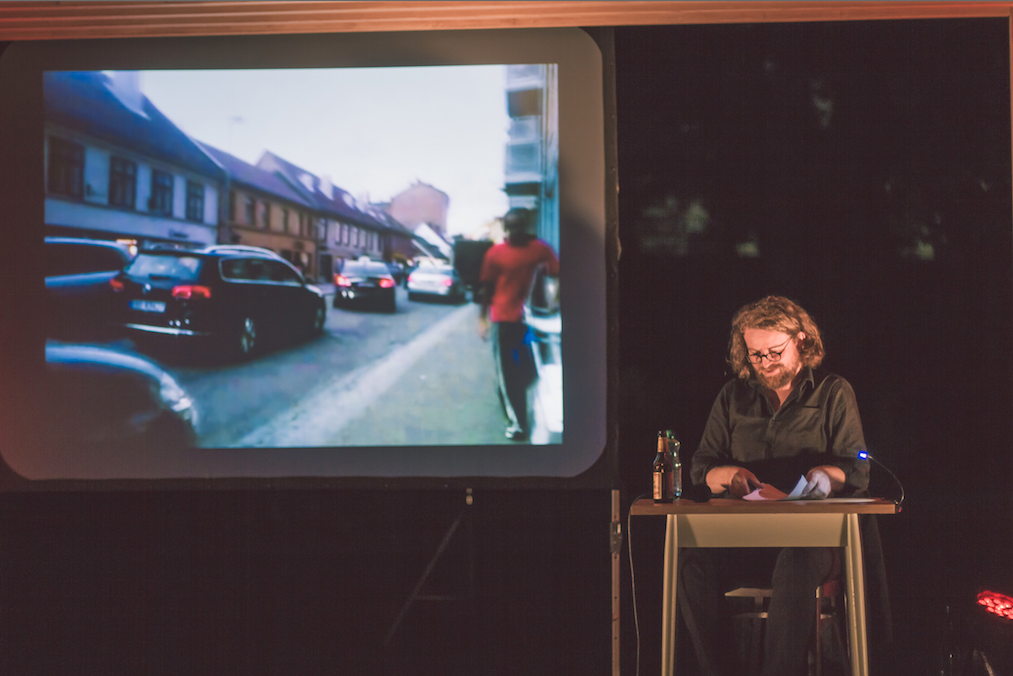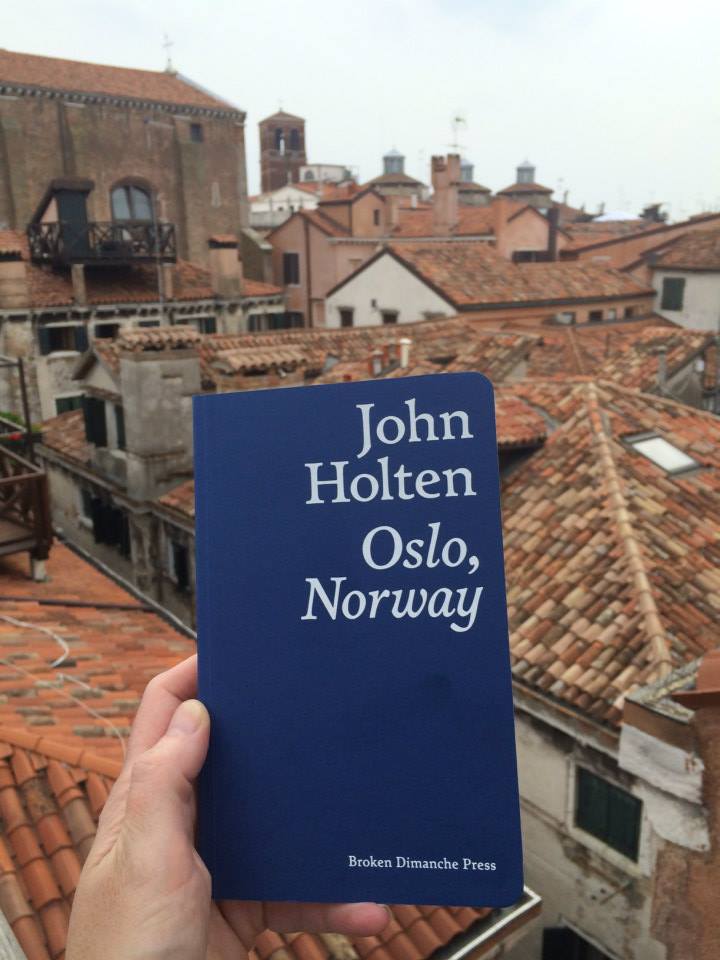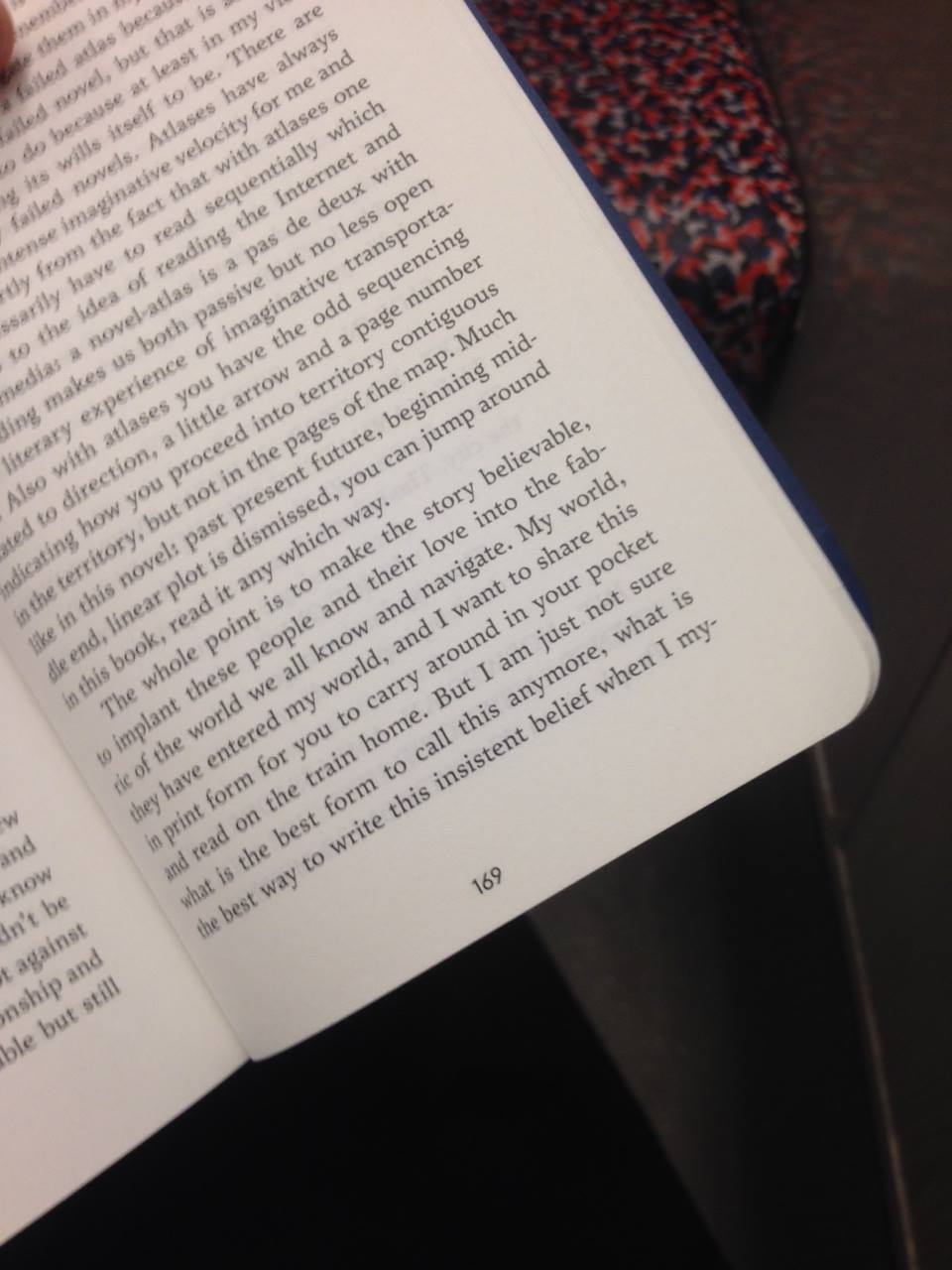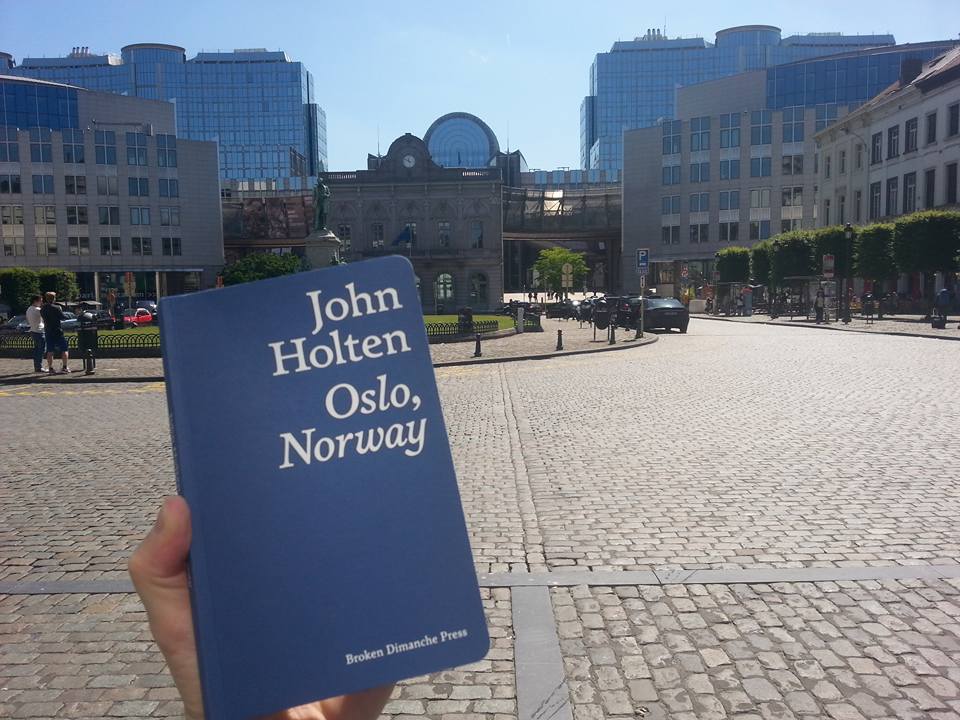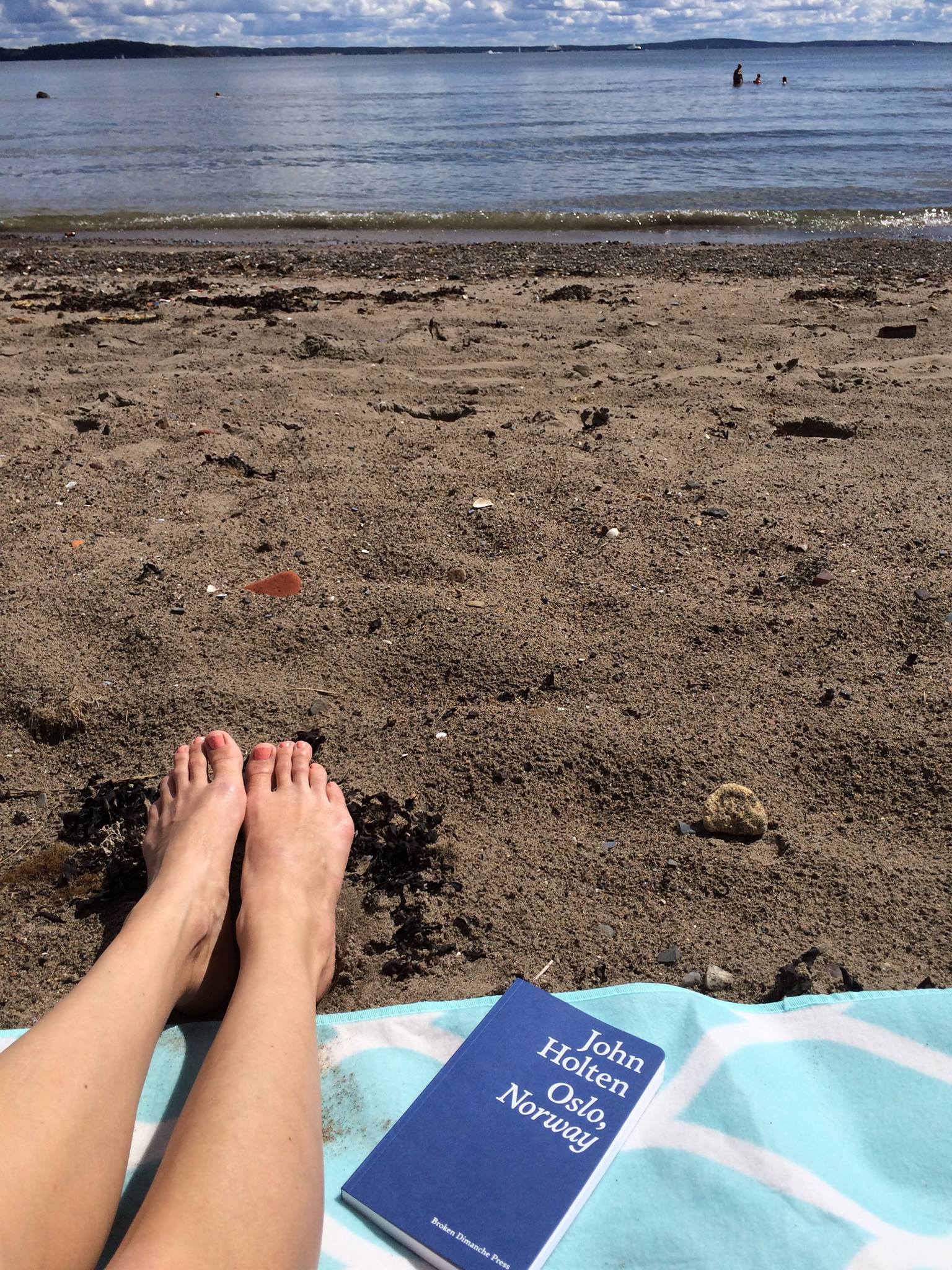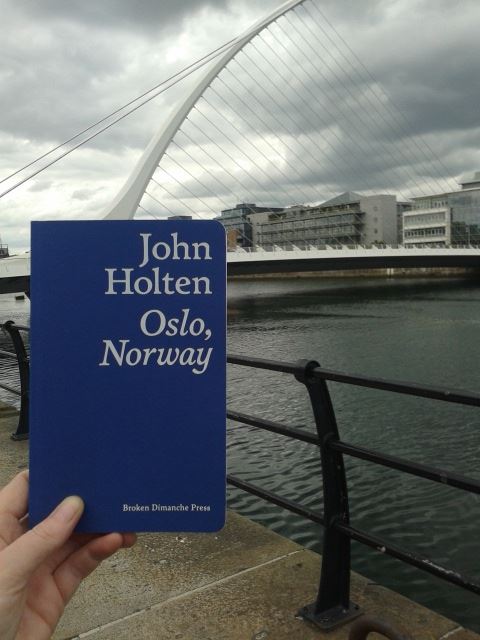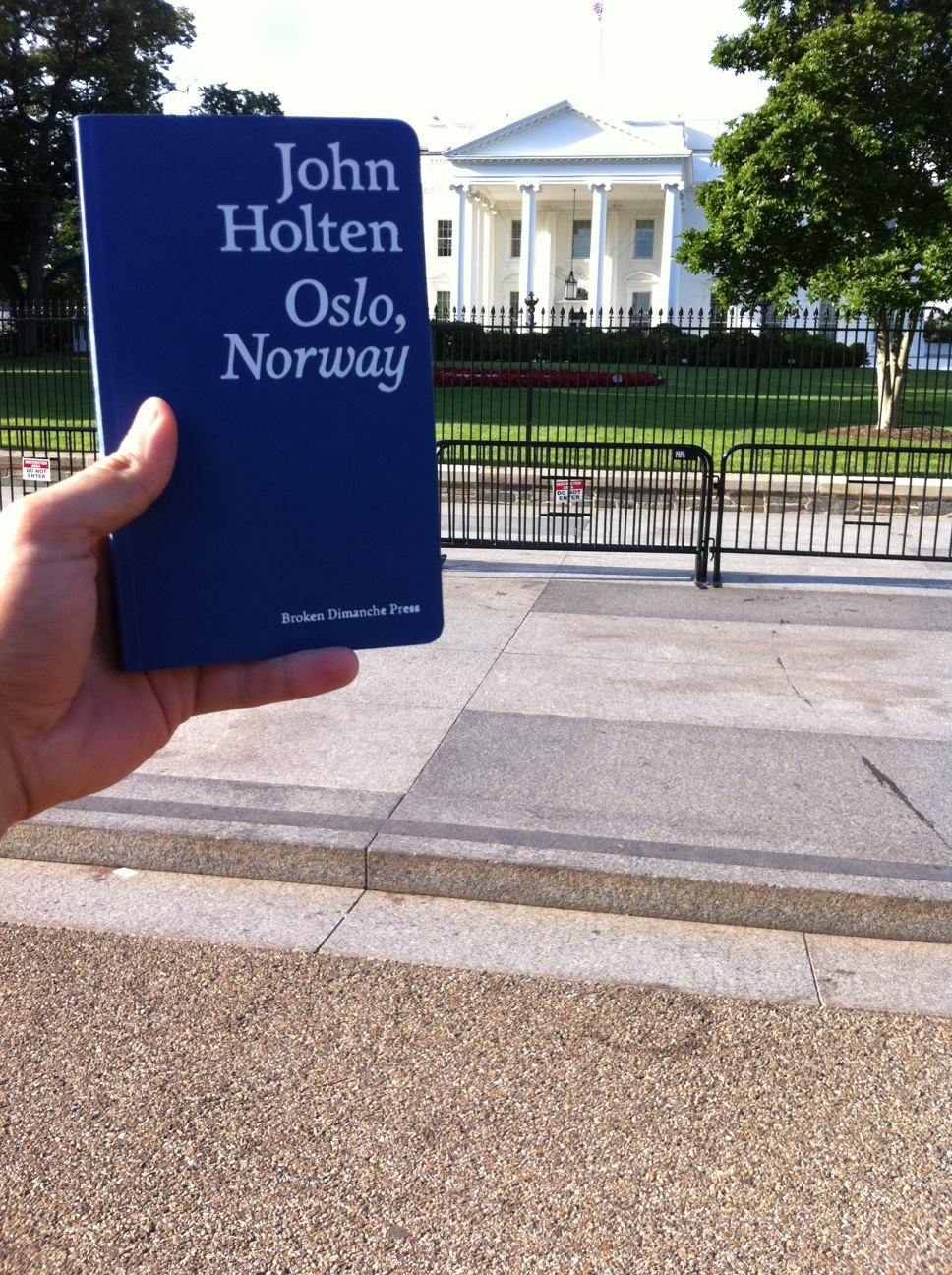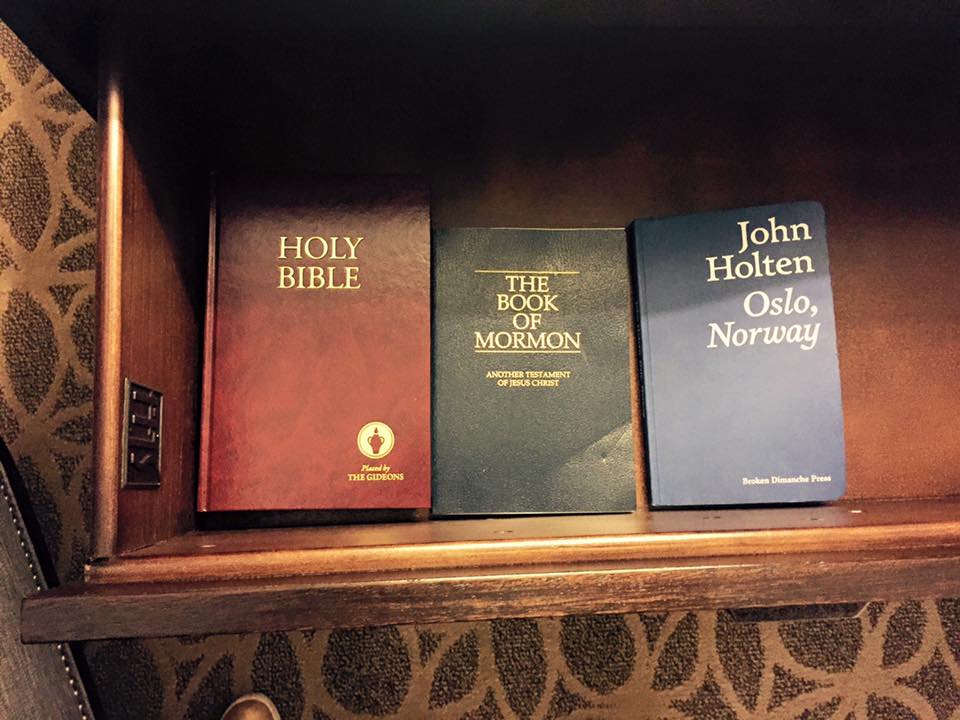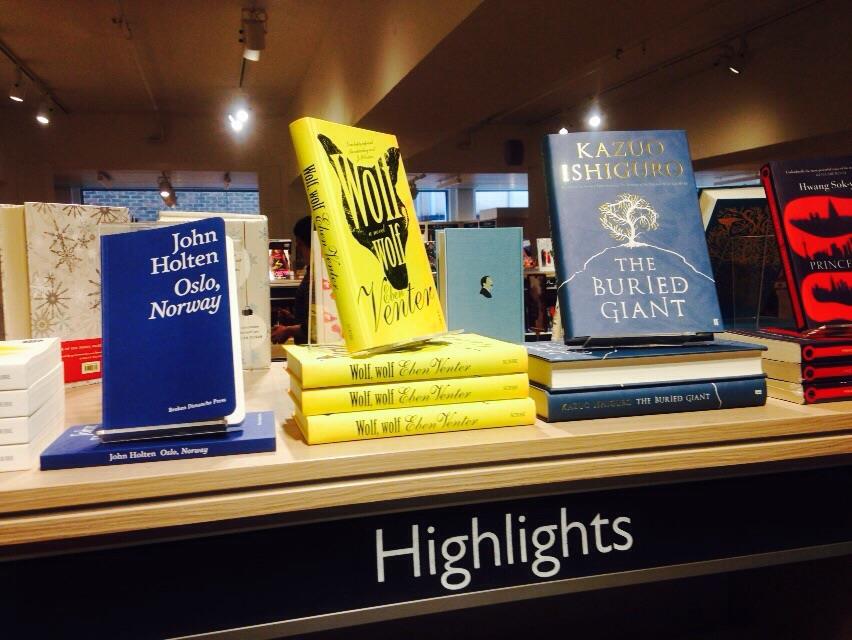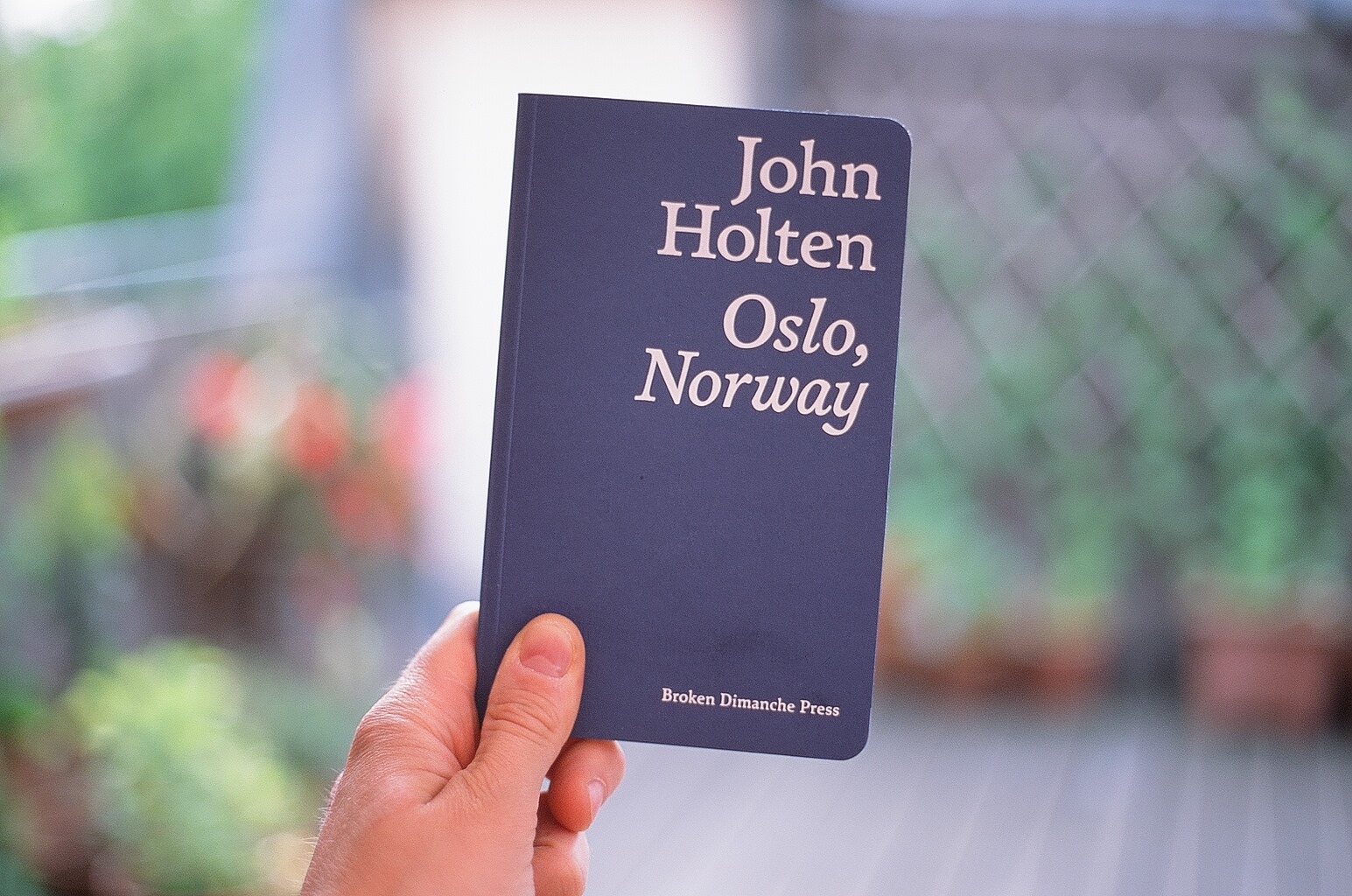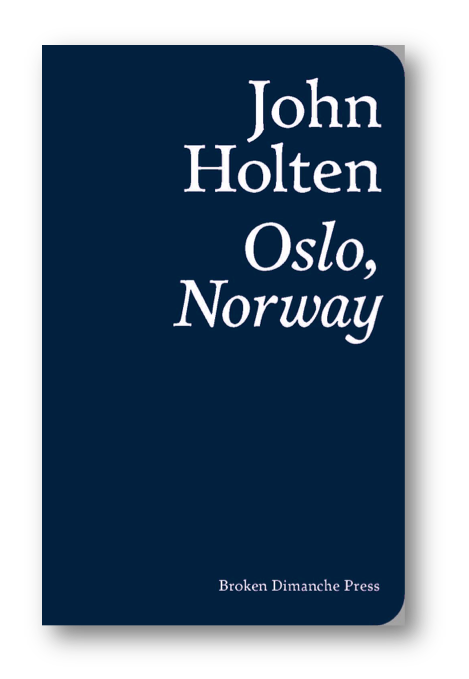A Literary Atlas for a Dispersed Form
John Holten interviewed by Rob Doyle.
[PDF]
The Readymades, John Holten‘s 2011 debut novel, was a marvel. A Bolañoesque, avant-garde page-turner, it trained a breezily pan-European sensibility on the story of a shadowy Serbian art collective at large in Paris, Vienna and Berlin. Alongside the book’s heady inventiveness, there were ample doses of sex, drugs and alcohol, and exhilarating, wistful evocations of being young, broke and brilliant in post-Cold War Europe. Beautifully published by Broken Dimanche, the press Holten himself co-established in Berlin, where he now lives, The Readymades was largely ignored by the literary mainstream. One of the most remarkable novels of recent years, it has been read by relatively few people. Earlier this year, Broken Dimanche Press published Holten’s second novel, Oslo, Norway. Slimmer than its predecessor, it is no less abundant in flair, formal daring, and breadth of vision. There are metafictional tricks and turns, effervescent sexuality, apocalyptic visions, ruined love, Nordic alienation, and a Cortazarian invitation to read the novel in any number of ways. Holten is as much of a wandering spirit as the bright young things without borders who populate his fiction. I tracked him down between various art exhibitions and projects he’s been involved in, to talk about books, art, influence, travel, the future of fiction, and why it’s fun to write about threesomes and drug binges.
Rob Doyle: How would you describe your new novel, Oslo, Norway to those who haven’t read it? What’s in there?
John Holten: Oslo, Norway is a novel that is also a personal, literary atlas of a city. A love story, it is also a strange mix of science fiction, speculative story telling, a tale of writer’s block and an oblique introduction to Norse myth. It is made up of three sections each with thirteen episodes and a final section or Legend also with thirteen episodes.
RD: While also functioning as a standalone work, Oslo, Norway is the second volume in what you have described as a roman-fleuve called the Ragnarok trilogy. When you started writing the first volume, The Readymades, to what extent did you already have a trilogy planned out? How did you know it would be a three-parter?
JH: I didn’t know much besides that I wanted to work across three main cities: Paris, Oslo and Berlin. And beyond that, some key images or ideas: a missing avant-garde group, a couple sitting on a train in Hamburg looking out as the lights go out, the German train network…
RD: So, we’ve had the lost Serbian avant-garde group in The Readymades and the doomed love affair in Oslo, Norway. Berlin has featured in both of the books so far. Will the third volume be primarily set there?
JH: Yes and no: it will lead there and revolve around a version of Berlin, past and future.
RD: What are the chief elements that tie all the parts together, and what else can we expect from the final volume?
JH: I have this clear idea of how this story needs three novels, the crossovers are subtle and feel like they almost happened by chance during the writing. The dictates of time, past present future, also conspire this formal direction. I have a passing interest in numerology and the number three is important, as is the geometric possibilities of the triangle, the pyramid in particular, as an imaginative and metaphorical indicator. Trifke, a minor character in The Readymades, plays a precipitate role in Oslo, Norway. The end of the world, the end of the status quo, love: these things tie them together. Perhaps. It seems the final volume will be about the nature of evil as well as trains.
RD: Oslo, Norway starts out as a more or less straightforward story, charting the painful love affair of William, a young Irish expat engineer, and Sybille, a beautiful and intensely sexual young woman. As in The Readymades, poignancy and emotional vulnerability go hand-in-hand with a keen eye for debauchery, the erotic allure of the night, and the hedonistic possibilities of youth. What is it that draws you to writing about such things?
JH: I don’t really know if I’m honest, as in life as in art: they can be fun. I remember how the opening few pages of The Readymades came about: I wanted to have this scene with wheedling maggots (Henry Miller) and people turning guns on fallen gods (Borges). It’s interesting that you say the possibilities of youth because I think The Readymades points towards the fact that time and aging makes such things obscene more than alluring. Old swingers can be quite sad or even threatening. I think aging is a terrible thing and have a morbid interest in it and all its sordid processes!
RD: Later in the novel, the story takes a wild, apocalyptic turn – and then appears to grind to a halt. Rather than try to gloss over this, your next move is to bring out further the metafictional strand (‘John Holten’ is a character in both this book and its predecessor), admitting your doubts and difficulties as to where the story should go next, indeed about fiction and the novel in general. ‘John Holten’ heads south, to Spain, and tries to figure out what to do. This felt like quite a risky move – bringing the audience behind the scenes, as it were, and showing them not just the inner workings, but also the writer’s doubts concerning his own materials. Did you ever fear that this could backfire on you?
JH: Writing Oslo, Norway really brought me to the point on several occasions where I had no idea why I was bothering: that wonderful and necessary point when the utter pointless nature of novel writing dawns on you is full of bathos and wonder. And yet, on I went. I decided the difficulty in telling the tale was part of the tale, in the same way that Darko’s artwork – or also the lacunae in the book within the book ‘To Warmann’ – were part of the tale of The Readymades. It did backfire on me, I spent over a year just shuffling sections around so that the dead ends of my story would align in an aesthetically pleasing way, which I hope they now have. I want the reader to decide and be an active agent, that’s why I call it a literary atlas. And I wanted to write a novel which didn’t fail if people just picked it up and read a part of it. Failure is integral to literature, and postmodernism allowed literature to be self aware and reveal its machinations: I think the point now is to have as much fun with these facts as you can while still having the courage to tell the story. Such that you can have fun writing a novel, but I think you can and genre fiction demonstrates that.
RD: Do you read much genre fiction? Both your novels contain certain genre elements (noir, pulp-thriller, even sci-fi).
JH: I guess I do yes, or rather I like to also read very conventional novels with intricate plot outlines and structure. I don’t read enough sci-fi, but have really enjoyed the weird fiction that I have read.
RD: Like a fair few of the interesting writers and novelists working today, you seem to be as deeply engaged with contemporary art as you are with prose fiction. It reminds me of Cioran’s suggestion that writers are only truly nourished when they read outside of their own sphere of activity: for instance, a poet will gain more by reading a book on botany than a book of poems. How does contemporary art nourish your work?
JH: This is a very interesting question for me right now. I went recently to a presentation of Artist Novels: The Book Lovers Publication, edited by David Maroto and Joanna Zielińska, the former being an artist and the latter a curator. And for them and their project the lines between who is an artist and who is a writer are so strict that it became frustrating for most people at the presentation, if necessary for their research. Increasingly I feel like these terms can be somewhat restrictive: contemporary art is a deeply literary place, especially right now when the poetic and the literary experience seem to be replacing theory as the favoured method of explication. And of course that is nothing new. From contemporary art I learn so much: methods of narration and presentation, working in the field, the relation of fact to fiction and how documentation can frustrate as much as it can facilitate any approach to the ‘Truth’ or realistic representation. I work with many artists in many different scenarios; they can be inspiring in their determination and self-reliance. Conversely in the other direction, you could almost say I am an artist whose training is in literature and whose media is the book and fiction. I also find that the history of the artist book and book-as-object is deeply inspiring and acutely relevant for anyone writing books – in whatever form – because of the digital turn and the changing modes of reading that have come about as our digital lives grow more complex.
RD: Existing harmoniously alongside your avant-garde sensibilities, you have a clear ability to write engrossing, propulsive, pleasure-giving fiction. Having looked squarely at your own doubts regarding the novel-form, its possible obsolescence in the internet age, the conventions of realist fiction, and so forth, how will you go on? Do you foresee a way out of this impasse?
JH: Yeah sure. I love fiction and think we live in a great age of fiction. The novel is such a wonderful form and I believe squarely in its original genesis, how as a bastard child it is beautiful in its ability to reinvent and adapt. I am interested in history. I am interested in love. I am interested in humour. These things I need to fit into something called a novel, and my obligation to this form called the novel means that whatever I write shouldn’t read, look or feel anything like a John McGahern novel. Not even an updated version! Because that would be anachronistic and stultify the form, contradicting it. Recently I tried on an Oculus Rift headset for the first time in an exhibition by Steegmann Mangrané in Esther Schipper gallery: this felt like a way out of any impasse! TV series: people love narrative and stories and characterisation so much now that people in the film industry are turning to TV. Like I said, it feels like a great age to be a literary storyteller. Actually Brian Dillon put it very nicely recently in Mousse magazine in an essay that looked at The Book Lovers project: ‘The novel – or maybe better the novelistic – is a dispersed form, its voice and narrative and texture flowing between media and between discrete works; the book as such is just one receptacle in which it might be deposited.’ That sounds about right to me. MFAs in Creative Writing (and I say this having done one) which espouse traditional notions of what a novel is: they are in fact enemies of the novel. ‘Experimental’ is a misnomer in this regard; novels of ideas, as the British like to quaintly put it, or experimental novels are anything but: they are in fact the novel’s heroes and proper descendants, their possible saviours.
RD: I didn’t know you had done an MFA. With regard to what you just said, was this primarily a negative, frustrating experience, or was there a spirit of openness and experimentalism regarding the novel?
JH: Not overly, but it was interesting to see up close the various ideas of what the definition of a novel is. It was more focused on the short story anyway, probably because of the nature of the workshop format. It did teach me how to give and receive feedback and criticism, very important for any writer. Also an insight into editing and publishing, which are things that I carried over into Broken Dimanche Press and ultimately the decision to go it alone without an agent, which is ironic considering that often people take these courses with an eye to getting represented and published. It also demonstrated clearly that not everyone who wants to write and spends time writing is cut out to be a writer.
RD: You have lived for much of your adult life outside of Ireland, mostly, it seems, in Paris and Berlin. What were the motivations behind this? Could you have written novels had you stayed in Ireland? Do you foresee yourself ever moving back there?
JH: I am sure I could have written novels in Ireland. I started to write a novel about the fetish for property and an economic crash while at Trinity and finished it in Oslo, it sadly got overtaken by real life economic events. When I was in Berlin I wrote about Paris (and Belgrade), as well as Oslo. I think I would find it very hard to write about Dublin in a way that you have, as a place it feels for me weirdly sacrosanct or something, like I wouldn’t do Ireland justice. But perhaps with time. I hope to spend more time in Dublin, the mix of people is something I really enjoy whenever there, and of course the singular nuances of language and humour.
RD: Like its predecessor, your new novel has been published by the press that you yourself set up, Broken Dimanche. Writers who self-publish used to be mocked and belittled – Martin Amis once used a half-million pound advance to write a novel that did just that – but your two books, in the beauty and care with which they have been produced as objects, as well as their literary originality and impressiveness, make all of that seem out-of-date, reactionary. Broken Dimanche feels pretty punk-rock, eschewing as it does the inherent conservatism of the publishing mainstream to create books that are fresh and unconventional. However, there must nonetheless be considerable drawbacks to taking this route, which at bottom amount to the problem of getting the books out there to readers. What has your experience with all this been like? Has it been frustrating to you that your novels have not had the same distribution, reviews, media-coverage and so on that they might have had, had you been published by an established press?
JH: Sure, like any novelist I’d like more readers and reviews, any reviews, good or bad! (So far, Oslo, Norway has just one, in Norwegian). I am very proud of my books and yes, it was a risk to publish The Readymades like I did. BDP wasn’t even all that old when it came out. It got very little literary establishment attention. If I had gone down the route of finding an agent and getting it published at a bigger house, it might have been a very different book in the end… It’d be nice to have an agent, a committed editor to build a relationship with, a publicity machine. But then, I have enjoyed great artistic freedom and built my own team to do as much. Ultimately I believe the cliché that if a book is good enough, or worthy enough, it will find its way. My own odd little books, I believe they’re finding their way. But it kind of gets back to you asking if I’ll keep on writing books: as I said, I will, but I’m not sure I can in this model. To write a novel is a huge undertaking, and the energy to produce beautiful objects and give them a decent life in the world is equally hard work. Self publishing is often worth making fun of, but Martin Amis is not allowed to; fuck Martin Amis.
RD: You have talked about how Oslo, Norway owes something to Julio Cortázar, in how, like his Hopscotch, it can be read in any order the reader prefers, rather than strictly linearly. Do you think you will continue to conceive your books in this way?
JH: I am an artist whose medium is fiction and the book as object is very capable of carrying that medium, but at the same time digital media has affected how we attend to and interact with any book. So yes, non linear reading is very important (this also feeds into why there has to be three books in which there can be some reading back and forth). I spend a lot of time thinking about books, the codex, the architecture of them. As I’ve said I am fascinated by how reading methods and habits are under going a full blown transformation. I think of how I read each day and how hard I have to fight to spend the requisite time to read novels, how distraction works on the turning of pages, and I want to match all this formally in the construction, the architecture, of my writing. That is why I like Dillon’s definition: the 21st century novel surely will exist across media. As has been said, if novelists don’t realise this tectonic shift in reading habits they are going to end up like basket weavers today: excellent craftspeople practising a timeless art, but not getting much of audience outside their own circle.
RD: Roberto Bolaño comes in for a bit of discussion in the book, and Karl Ove Knausgaard is alluded to (his pre-My Struggle novel about angels is passed between characters, providing a link between the two books in the series so far). What other writers are you currently engaged with, and which have exerted the strongest influence or provided the most inspiration for your writing? Are the authors I’ve named here important to you?
JH: Sure, Bolaño is of deep importance to me: I still find myself surprised and delighted that he should have existed at all, and during my lifetime what is more. Enrique Vila-Matas, and the four books of his translated to date into English were important to me during the writing of Oslo. Knausgaard was interesting to me because Line Madsen Simenstad told me he was good. I even wrote a long, rambling review of A Time to Every Purpose while writing The Readymades. This novel is important to how I envisage the end result of Ragnarok. The fact that his My Struggle deals with the real and factual in a literary, auto-fictional way, plus being Norwegian, made it interesting for my own little experiments in exploding the potential of literary realism. War and War by Laszla Krasznahorka left a deep mark, especially with regard to trying to turn a gaze on New York from behind the European trench as it were. It was nice that he received this year the International Man Booker Prize. In terms of Irish novelists, I was always attracted to those outward looking novelists, all deforming the form a little more, each in their own way, Sterne, Joyce, Beckett, O’Brien, Higgins, O’Reilly…
ABOUT THE INTERVIEWEE
John Holten is a writer and artist as well as a publisher. Born in 1984 in Ireland, he studied at University College Dublin and the Sorbonne-Paris IV before obtaining an MPhil from Trinity College Dublin. In 2011 John published his first novel The Readymades to great acclaim, and the art group he created in the novel, The LGB Group, enjoyed exhibitions in many cities as well as being included in The Armory Show, New York in 2012. Having co-founded Broken Dimanche Press as an international art press in 2009, John has overseen as Editor-In-Chief more than thirty publications and attendant exhibitions, projects and public events. Most recently he travelled to the Congo with artist Richard Mosse for whom he edited A Supplement to The Enclave as part of Mosse’s Deutsche Boerse Photography Prize winning exhibition in London. You Are Here, the first book published by Broken Dimanche Press, won at the Charlemagne European Youth Prize in 2010. As well as this editorial work, John has also written for many artists such as Natalie Czech, Mahony, Darri Lorenzen and Jani Ruscica, often working closely with them to produce immersive or participatory texts. His work has appeared in many international contemporary art settings such as Malmö konsthall, The White Building London, David Zwirner Gallery New York (with Aengus Woods), NGBK and Agora, Berlin and Villa Romana, Florence amongst others. His video commercials for Oslo, Norway have been exhibited in Plan B Gallery and Team Titanic, Berlin, Extrapool, Nijmegen and Thyssen-Bornemisza Art Contemporary, Vienna. A version of Oslo, Norway was published in gorse no. 1.
ABOUT THE INTERVIEWER
Rob Doyle was born in Dublin, and holds a first-class honours degree in Philosophy and an MPhil in Psychoanalysis from Trinity College Dublin. His novel, Here Are the Young Men, is published by Bloomsbury, and was chosen as a book of the year by the Irish Times, Sunday Times, Sunday Business Post, and Independent. It was shortlisted for the Irish Book Awards Newcomer of the Year prize. His second book, This Is the Ritual, will be published in January 2016 (Bloomsbury / Lilliput). Rob’s fiction, essays, and criticism have appeared in the Dublin Review, The Stinging Fly, The Irish Times, The Sunday Times, The Sunday Business Post, and gorse nos. 1 and 2. He is currently playing the lead role in a feature film to be released in 2016.

